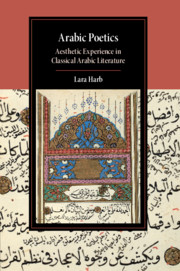Book contents
- Arabic Poetics
- Cambridge Studies in Islamic Civilization
- Arabic Poetics
- Copyright page
- Dedication
- Contents
- Preface
- Acknowledgments
- Note on Dates, Translations, Transliterations, and Names
- Introduction
- 1 Wonder
- 2 Wonder in Aristotelian Arabic Poetics
- 3 Discovery in Bayān
- 4 Metaphor and the Aesthetics of the Sign
- 5 Naẓm, Wonder, and the Inimitability of the Quran
- Epilogue
- Conclusion
- Bibliography
- Index
- Other Titles in the Series
2 - Wonder in Aristotelian Arabic Poetics
Published online by Cambridge University Press: 24 April 2020
- Arabic Poetics
- Cambridge Studies in Islamic Civilization
- Arabic Poetics
- Copyright page
- Dedication
- Contents
- Preface
- Acknowledgments
- Note on Dates, Translations, Transliterations, and Names
- Introduction
- 1 Wonder
- 2 Wonder in Aristotelian Arabic Poetics
- 3 Discovery in Bayān
- 4 Metaphor and the Aesthetics of the Sign
- 5 Naẓm, Wonder, and the Inimitability of the Quran
- Epilogue
- Conclusion
- Bibliography
- Index
- Other Titles in the Series
Summary
Chapter 2 demonstrates that a similar shift took place in the reception of Aristotle’s Poetics in Arabic. Arabic philosophy was faced with the problem of making sense of the poetic as a type of syllogism, since it inherited a classification of Aristotle’s treatise as part of his books on logic (the Organon). While initial attempts in late antiquity distinguished the poetic from other types of syllogism based on its falsehood, Arabic philosophy, especially with Avicenna (d. 1037), decoupled the poetic from truth and falsehood and distinguished the kind of conclusion that one attains through the poetic syllogism as “make-believe” (takhyīl). This new solution shifted the assessment of the poetic from a statement’s truth and falsehood to its ability to conjure a make-believe image. This process was also expected to allow for an experience of discovery and wonder in the listener according to the philosophers. While Aristotle discussed wonder as resulting from manipulations of a tragic plot, Arabic philosophy developed a theory of wonder resulting from the verbal arts, especially simile and metaphor. The chapter follows the development of these ideas in the works of Averroes (d. 1198), al-Qarṭājannī (d. 1285), and al-Sijilmāsi (d. c. 1330).
Keywords
- Type
- Chapter
- Information
- Arabic PoeticsAesthetic Experience in Classical Arabic Literature, pp. 75 - 134Publisher: Cambridge University PressPrint publication year: 2020

